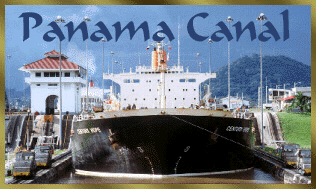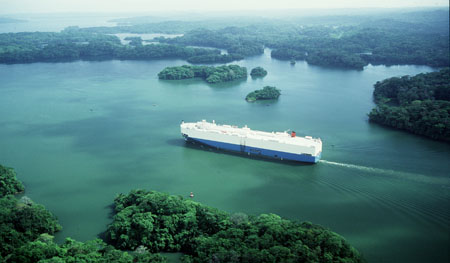


As our cruise ship approached the Caribbean side of Panama, we could see a long string of stones on either side of the boat with an opening large enough to pass through. This breakwater passage protects the upcoming locks from massive wave action.
Soon we view the Gatun Locks, at the north end of the Canal, which clearly shows its two lanes and three chambers. To the left we see the Gatun lighthouse and ahead the rather insignificant looking centerwall Control House. Our ship will be raised 85 feet in three steps to the level of Gatun Lake.
 Gatun Lake, a high-level lake whose surface is 85 feet above sea
level, was formed by the construction of Gatun Dam on the Atlantic
side of the Isthmus near the mouth of the Chagres River. Panama's
lakes and rivers are fed by tropical rains that fall copiously in
the highlands during the 8-month rainy season between mid-April and
mid-December. Vessels travel some 23 1/2 miles through Gatun Lake
between Gatun Locks and Gaillard.
Gatun Lake, a high-level lake whose surface is 85 feet above sea
level, was formed by the construction of Gatun Dam on the Atlantic
side of the Isthmus near the mouth of the Chagres River. Panama's
lakes and rivers are fed by tropical rains that fall copiously in
the highlands during the 8-month rainy season between mid-April and
mid-December. Vessels travel some 23 1/2 miles through Gatun Lake
between Gatun Locks and Gaillard.
Here we relived the dramatic chapter in history when two oceans were joined in an earth-moving endeavor that altered the geography of the America's forever. Dams stopped the rivers in their tracks. Valleys became lakes. Mountains, islands. The Continental Divide was reduced by a winding channel.
The canal has three sets of locks (Gatun, Pedro Miguel and Miraflores), Madden and Gatun dams that form Madden and Gatun Lakes, Miraflores Lake and the terminal cities of Colon on the Atlantic and Panama City on the Pacific. We passed through only the Gatun locks and anchored for some time within the Gatun lake. There passengers could disembark on life boats to the shores of the lake. We were the first ship ever to be allowed to do this. For that we were all given certificates attesting to that.
At Gatun there are 2 parallel sets of locks each consisting of 3 flights. This set of locks lifted our ship gently up to the Gatun and again ever so gently back down to the Atlantic , using no other power than the force of gravity - and 53 million gallons of water!. The locks are constructed from concrete from which the aggregate originated from the excavated rock at Culebra. The excavated rock was crushed and then used as aggregate. In excess of 1.53 million cubic meters of concrete was used in the construction of the Gatun locks alone.
If the Seven Wonders of the World were expanded, the Panama Canal would surely be a candidate.
San Blas Islands
Off the eastern coast of Panama are the San Blas Islands. The peoples there, the Kuna’s, are a community of proud people that have their own laws, norms and values that go with their culture, which is, by the way, totally different than the traditional Panamanian culture. Most Kuna Indians, an estimated 300.000, live in Panama, Costa Rica and Colombia.
Few outsiders come to the islands but, we did and were enthusiastically, approached by natives wanting to sell us their hand made wares.
The Kuna mainly survive by fishing and harvesting fruits, especially coconuts. The Kuna’s also create art on their bodies and clothes that they call Molas. The main language spoken by the Kuna’s is Kuna but they also tend to speak Spanish and a few who have been in contact with tourists speak a little English. We didn’t find anyone who did.